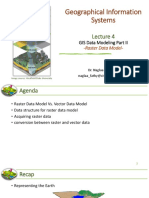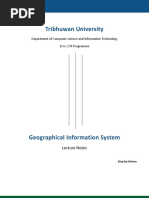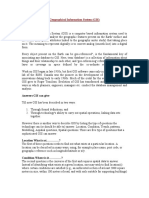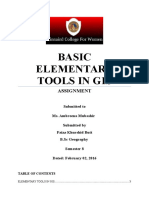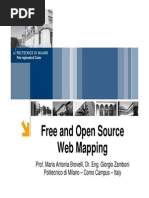GIS Data Formats
Uploaded by
bebebrendaGIS Data Formats
Uploaded by
bebebrendaGIS Data Types:
Vector vs. Raster
Basic Elements: Location (x,y) or (x,y,z) Explicit, i.e. pegged to a coordinate system Different coordinate system (and precision) require different values o e.g. UTM as integer (but large) o Lat, long as two floating point numbers +/ Points are used to build more complex features Advantages of Vector Data Structures: Good representation of phenomenonology Compact Topology can be completely described Accurate graphics Retrieval, updating and generalization of graphics and attributes possible Disadvantages of Vector Data Structures: Complex Data Structures Combination of several vector polygon maps through overlay creates difficulties Simulation is difficult because each unit has a different topological form Display and plotting can be expensive, particularly for high quality color The technology is expensive, particularly for the more sophisticated software and hardware Spatial analysis and filtering within polygons are impossible
VECTOR
RASTER
Basic Elements: Extent o # Rows o # Columns Origin Orientation Resolution: pixel = grain = grid cell Advantages of Raster Data Structures: Simple data structures Overlay and combination of maps and remote sensed images easy Some spatial analysis methods simple to perform Simulation easy, because cells have the same size and shape Technology is cheap Disadvantages of Raster Data Structures: The use of large cells to reduce data volumes means that phenomenonologically recognizable structures can be lost and there can be a serious loss of information Crude raster maps are considerably less beautiful than line maps Network linkages are difficult to establish Projection transformations are time consuming unless special algorithms or hardware is used.
VECTOR FORMATS 1. Shapefile
Contains: o Point, or multi-point o Line, or polyline o Polygon Raster (Grid)
2. Coverage
Contains: o Point, or node o Arc, or line o Polygon o Label
EXAMPLES
Temperature (air, water) Air pressure Ecotones Soil ph Precipitation Salinity Elevation & its derivatives Flow Direction, distance Reflectance (photography/imagery)
Vector (Feature)
EXAMPLES
Administrative borders Linear features Roads Rivers Discrete habitat boundaries Real-world
http://gif.berkeley.edu
You might also like
- Basic GIS Operations: Review of Data Formats in GISNo ratings yetBasic GIS Operations: Review of Data Formats in GIS20 pages
- Khadar Abdisalam, M.SC University of Hargeisa: Introduction To Geographic Information Systems (GIS)No ratings yetKhadar Abdisalam, M.SC University of Hargeisa: Introduction To Geographic Information Systems (GIS)29 pages
- GIS For Resource Assessment Management: Dr.R.Jaganathan Deartment of Geography University of Madras Chennai-600005No ratings yetGIS For Resource Assessment Management: Dr.R.Jaganathan Deartment of Geography University of Madras Chennai-60000579 pages
- Geographical Information System: - To Answer Apparently Simple Geographic Question LikeNo ratings yetGeographical Information System: - To Answer Apparently Simple Geographic Question Like18 pages
- Tribhuwan University: Department of Computer Science and Information Technology B.SC - CSIT Programme100% (1)Tribhuwan University: Department of Computer Science and Information Technology B.SC - CSIT Programme90 pages
- (GIS - 23) - Lecture 1 - Introduction To GISNo ratings yet(GIS - 23) - Lecture 1 - Introduction To GIS25 pages
- (GIS'23) Lecture 3 - GIS Data Representation & ModelingNo ratings yet(GIS'23) Lecture 3 - GIS Data Representation & Modeling33 pages
- GIS 2 (Applications of Elementary Tools in GIS)No ratings yetGIS 2 (Applications of Elementary Tools in GIS)10 pages
- Unit 3 GIS Data Sources and Structures 1No ratings yetUnit 3 GIS Data Sources and Structures 123 pages
- Lecture 01 - Introduction To GIS (Part - I)No ratings yetLecture 01 - Introduction To GIS (Part - I)18 pages
- GIS Lecture Notes Encoded PDF by Sewoo..No ratings yetGIS Lecture Notes Encoded PDF by Sewoo..47 pages
- Geomatic Concepts: Sr. Dr. Mustaffa Bin Anjang Ahmad100% (2)Geomatic Concepts: Sr. Dr. Mustaffa Bin Anjang Ahmad50 pages
- PGE 317: Map Reading, Remote Sensing and GIS: Lecture 3-4: Data Model & Geospatial DataNo ratings yetPGE 317: Map Reading, Remote Sensing and GIS: Lecture 3-4: Data Model & Geospatial Data50 pages
- Spatial Data Presentation and VisualizationNo ratings yetSpatial Data Presentation and Visualization8 pages
- 15CV563 Remote Sensing and GIS Model Question Paper: Time - 3hrs V Sem Civil Max. Marks-80No ratings yet15CV563 Remote Sensing and GIS Model Question Paper: Time - 3hrs V Sem Civil Max. Marks-802 pages
- 2 - Spatial Data Types - Raster - VectorNo ratings yet2 - Spatial Data Types - Raster - Vector22 pages
- Name of Satellite Network Orbital Position (Degrees West) Frequency Bands (GHZ) Commercial Itu Filing Downlink UplinkNo ratings yetName of Satellite Network Orbital Position (Degrees West) Frequency Bands (GHZ) Commercial Itu Filing Downlink Uplink2 pages






